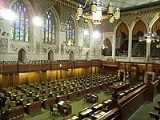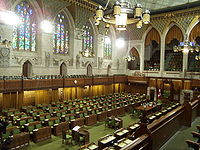
Section Five of the Canadian Charter of Rights and Freedoms
Encyclopedia

Constitution of Canada
The Constitution of Canada is the supreme law in Canada; the country's constitution is an amalgamation of codified acts and uncodified traditions and conventions. It outlines Canada's system of government, as well as the civil rights of all Canadian citizens and those in Canada...
, and the last of three democratic
Democracy
Democracy is generally defined as a form of government in which all adult citizens have an equal say in the decisions that affect their lives. Ideally, this includes equal participation in the proposal, development and passage of legislation into law...
rights in the Charter
Canadian Charter of Rights and Freedoms
The Canadian Charter of Rights and Freedoms is a bill of rights entrenched in the Constitution of Canada. It forms the first part of the Constitution Act, 1982...
. Its role is to establish a rule regarding how frequently the Parliament of Canada
Parliament of Canada
The Parliament of Canada is the federal legislative branch of Canada, seated at Parliament Hill in the national capital, Ottawa. Formally, the body consists of the Canadian monarch—represented by her governor general—the Senate, and the House of Commons, each element having its own officers and...
and the legislatures of the provinces and territories of Canada
Provinces and territories of Canada
The provinces and territories of Canada combine to make up the world's second-largest country by area. There are ten provinces and three territories...
must meet. This section is thus meant to reflect and constitution
Constitution
A constitution is a set of fundamental principles or established precedents according to which a state or other organization is governed. These rules together make up, i.e. constitute, what the entity is...
ally guarantee a "basic democratic principle" that "a government must explain its actions to the people."
The section reads,
Function
Section 5 guarantees that, since Parliament and each legislature must sit at least once a year, Members of ParliamentMember of Parliament
A Member of Parliament is a representative of the voters to a :parliament. In many countries with bicameral parliaments, the term applies specifically to members of the lower house, as upper houses often have a different title, such as senate, and thus also have different titles for its members,...
and Members of the Legislative Assemblies may raise concerns or inquiries or challenge government policies (See Question Period
Question Period
Question Period, known officially as Oral Questions occurs each sitting day in the Canadian House of Commons. According to the House of Commons Compendium, “The primary purpose of Question Period is to seek information from the Government and to call it to account for its actions.”-History:The...
).
This right did not exist in the Canadian Bill of Rights
Canadian Bill of Rights
The Canadian Bill of Rights is a federal statute and bill of rights enacted by Prime Minister John Diefenbaker's government on August 10, 1960. It provides Canadians with certain quasi-constitutional rights in relation to other federal statutes...
. Insofar as the Parliament of Canada is concerned, section 5 instead replaced section 20 of the Constitution Act, 1867
Constitution Act, 1867
The Constitution Act, 1867 , is a major part of Canada's Constitution. The Act created a federal dominion and defines much of the operation of the Government of Canada, including its federal structure, the House of Commons, the Senate, the justice system, and the taxation system...
, which had read:
When the Charter came into force in 1982 as part of the Constitution Act, 1982
Constitution Act, 1982
The Constitution Act, 1982 is a part of the Constitution of Canada. The Act was introduced as part of Canada's process of "patriating" the constitution, introducing several amendments to the British North America Act, 1867, and changing the latter's name in Canada to the Constitution Act, 1867...
, section 53 of the Constitution Act, 1982 repealed section 20 of the Constitution Act, 1867. The difference was that section 5 merely requires a sitting of Parliament at least once a year, whereas section 20 had required not only a sitting but also a session of Parliament every year. Every session must begin with a Speech from the Throne
Speech from the Throne
A speech from the throne is an event in certain monarchies in which the reigning sovereign reads a prepared speech to a complete session of parliament, outlining the government's agenda for the coming session...
, and moreover, bills that had not been passed when a session comes to a close must be introduced again, after a new session is initiated, if it is still desired to become law. Hence, governments sometimes prefer that sessions last longer than the twelve months that had been prescribed by the Constitution Act, 1867. Writing in 2000, political scientist Rand Dyck
Rand Dyck
Dr. Perry Rand Dyck, B.A., M.A., Ph.D. Professor Emeritus, Laurentian University is the author of the Canadian Politics: Critical Approaches textbook which is used in many Canadian Universities, and taught to students studying Political Science, Law, Economics, Women's Studies, Philosophy,...
observed that while sessions even now usually last a year, they "often spilled over to two or even three years." Even before 1982, governments sometimes extended session lengths to give more time to parliamentary committees to work, even though the Canadian House of Commons
Canadian House of Commons
The House of Commons of Canada is a component of the Parliament of Canada, along with the Sovereign and the Senate. The House of Commons is a democratically elected body, consisting of 308 members known as Members of Parliament...
and Canadian Senate
Canadian Senate
The Senate of Canada is a component of the Parliament of Canada, along with the House of Commons, and the monarch . The Senate consists of 105 members appointed by the governor general on the advice of the prime minister...
would stop working.
As far as the province of Manitoba
Manitoba
Manitoba is a Canadian prairie province with an area of . The province has over 110,000 lakes and has a largely continental climate because of its flat topography. Agriculture, mostly concentrated in the fertile southern and western parts of the province, is vital to the province's economy; other...
is concerned, section 5 of the Charter replaced section 20 of the Manitoba Act
Manitoba Act
The Manitoba Act, originally titled An Act to amend and continue the Act 32 and 33 Victoria, chapter 3; and to establish and provide for the Government of the Province of Manitoba, is an act of the Parliament of Canada that is defined by the Constitution Act, 1982 as forming a part of the...
, which was also repealed in 1982. Section 5 still co-exists with section 86 of the Constitution Act, 1867, which requires annual sessions for the legislatures of the provinces of Ontario
Ontario
Ontario is a province of Canada, located in east-central Canada. It is Canada's most populous province and second largest in total area. It is home to the nation's most populous city, Toronto, and the nation's capital, Ottawa....
and Quebec
Quebec
Quebec or is a province in east-central Canada. It is the only Canadian province with a predominantly French-speaking population and the only one whose sole official language is French at the provincial level....
.
Enforcement
There are no examples in Canadian history of cabinets ruling without consulting Parliament at least once a year. If it were to happen, Professor Gérald-A. Beaudoin wrote in 1982 that section 5 would not allow courts to take any remedial action besides ruling the government's refusal to let a legislature sit is inappropriate. If it were necessary to resolve the problem, the Governor General of CanadaGovernor General of Canada
The Governor General of Canada is the federal viceregal representative of the Canadian monarch, Queen Elizabeth II...
would have to appoint a new government and new prime minister
Prime Minister of Canada
The Prime Minister of Canada is the primary minister of the Crown, chairman of the Cabinet, and thus head of government for Canada, charged with advising the Canadian monarch or viceroy on the exercise of the executive powers vested in them by the constitution...
.

